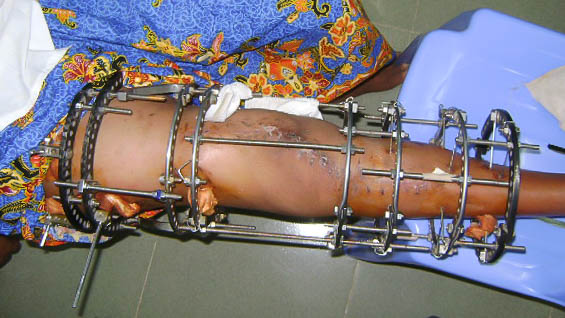
In February 2015, Lithuanian MIST led by Dr Jaunius Kurtinaitis visited CSC, and followed in March 2015 by another team from Lithuania led by Dr Saulius.
Most of the cases are mal-unions, non-unions of previously treated fractures or infections following operative intervention .
The patients are followed-up by CSC who are in constant communication with the Foundation in case any complications arise requiring prompt management.
From 2013 to date, the Foundation has been involved in 76 cases at CSC of varying aetiology and complexity.


MIST has been sending Limb Reconstruction Teams to Cambodia on a regular basis since May 2013 with the remit of treating patients in need of limb reconstruction whilst educating and training the cambodian surgeons in the use of Ilizarov surgery and ring fixators.
A short history of the CSC, Cambodia
Jim Gollogly first came to Cambodia in the early 1990s for a six-month assignment with the American Red Cross. After thirty years of war and genocide by the Pol Pot regime during which the country’s educated were targeted for execution, the medical system suffered tremendously.
On arrival in Cambodia, Dr. Jim found that various disabilities and landmine injuries were rampant. Facilitated by the people he met during that first assignment, he returned to Cambodia in 1998, following the UN-backed elections.

CSC started as a small project to help victims of landmine injuries, many of whom were children. Since then CSC has grown into a well-equipped and well-organised hospital. relative to others locally. Their patient database and out patient clinic meant that with prior knowledge of our visit our time could be used efficiently. Some suitable complex patient cases pertaining to our sub-specialty were asked to attend clinic. After consultation a management plan for each patient was discussed and documented into the patient’s e-file. This was a very efficient use of our time at CSC.
The theatres were arranged in a ‘barn’ concept with 5 operating tables working simultaneously. The theatres were rudimentary with only one radiolucent table, and an Image Intensifier that had seen better days. The Anaesthetics equipment and Department were made of more sturdy stuff. The doctors were courteous and masters at local blocking techniques, as well as general anaesthesia for children undergoing cleft palate surgery.
Following a daily 8am morning X-ray meeting, the cases for the day’s operating were discussed and equipment made available. Out-patient clinics would run simultaneously as the operating theatres with any spare time spent in teaching and training the local surgeons and nurses. The Orthopaedic residents that had joined in the mission would act as database in-putters and assistants in theatre cases.
A number of patients have been treated at CSC by MIST whilst teaching the junior CSC surgeon. Most of the cases are mal-unions, non-unions of previously treated fractures or infections following operative intervention. The patients are followed-up by CSC who are in constant communication with the Foundation in case any complications arise requiring prompt management. From 2013 to date, the MIST has been involved in 76 cases at CSC of varying aetiology and complexity.



